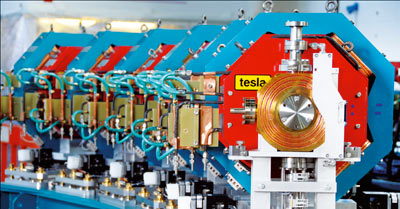
Image credit: STFC.
On Tuesday 22 June at 10.37 p.m. an electron beam passed for the first time through four sectors of EMMA, the prototype that has been built at the UK’s Daresbury Laboratory to test the concept of the nonscaling fixed-field alternating gradient accelerator (FFAG). As the beam passed more than half way round the accelerator’s circumference it marked a world “first” and demonstrated the underlying soundness of the most technically demanding aspects of the design.
FFAGs have a ring of magnets to focus the beam strongly, as in an alternating-gradient synchrotron, but the fixed magnetic field means that the beam spirals outwards as it is accelerated, as in a cyclotron. The result is more compact than a cyclotron, however, and although the concept is some 50 years old such machines are now being considered world-wide for a variety of applications. EMMA, the Electron Model for Many Applications, is a 20 MeV accelerator, which will test for the first time the concept of the nonscaling FFAG, in which the betatron tunes (the frequency of the transverse oscillations) are allowed to vary during the acceleration process. Nonscaling FFAGs are attractive because they tend to have much smaller transverse apertures than scaling FFAGs (where the beam optics remain constant during acceleration), which were first demonstrated at KEK in 2000.
EMMA has been built at the Daresbury Laboratory of the Science and Technology Facilities Council, under the auspices of the project for the COnstruction of a Nonscaling FFAG for Oncology, Research and Medicine (CONFORM). The electron beam injected into EMMA is generated by another novel accelerator system at Daresbury, the Accelerators and Lasers in Combined Experiments (ALICE). ALICE is the first accelerator in Europe to operate using energy recovery, where the energy used to create its high-energy beam is captured and reused after each circuit of the accelerator for further acceleration of fresh particles.
The next steps for EMMA, which are now underway, are to complete commissioning of the full ring, followed by the world’s first demonstration of the new acceleration technique.





